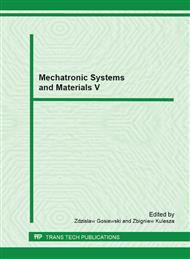p.93
p.99
p.105
p.111
p.117
p.123
p.131
p.137
p.143
The Analysis of Finishing Tooling Influence on Contact Fatigue Researched by Profilometer
Abstract:
The article presents the research results referring to the analysis of the influence of finish treatment ( lathing, grinding, burnishing) on the contact fatigue of steel applied to marine pump shafts. The research was performed on a roller 40 mm in diameter made of 304L stainless steel. Within the research, the optimalization of burnishing technological parameters was conducted on account of the minimalization of Ra surface roughness coefficient as well as the maximalization of SU degree of surface layer relative hardness [. The multi criteria optimalization conducted by min-max method [ with regard to minimum surface roughness as well as maximum degree of surface layer hardness demonstrated that burnishing process should be carried out at the following technological parameters: burnishing force 1.1 kN, burnishing speed 35 m/min, feed 0.13 mm/rev. In addition, the influence of the burnisher passes number on the surface layer quality was determined [.The paper will present the research results of contact fatigue examination of samples after finish machining.
Info:
Periodical:
Pages:
117-122
Citation:
Online since:
March 2013
Authors:
Keywords:
Price:
Сopyright:
© 2013 Trans Tech Publications Ltd. All Rights Reserved
Share:
Citation:


